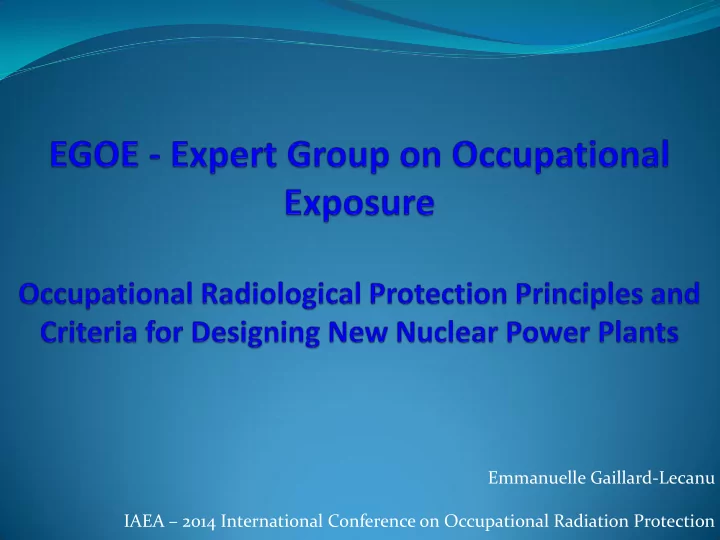

Emmanuelle Gaillard-Lecanu IAEA – 2014 International Conference on Occupational Radiation Protection
What is EGOE? Organisation for Economic OECD Co-operation and Development NEA Nuclear Energy Agency Committee on Radiation CRPPH Protection and Public Health EGOE « Expert group » for the CRPPH: Occupational Exposure EGOE met for the first time in January 2007 This report (“ Occupational Radiological Protection Principles and Criteria for Designing New Nuclear Power Plants ”) was issued in 2010
EGOE Members in 2010 Bulgaria Georgi VALCHEV Japan Kozloduy Nuclear Power Plant Yoshohisa HAYASHIDA Energy Safety Organisation (JNES) Canada Shigeru KUMAZAWA Energy Safety Organisation (JNES) Kevin BUNDY Canadian Nuclear Safety Commission (CSNC) Wataru MIZUMACHI Energy Safety Organisation (JNES) Salah DJEFFAL Canadian Nuclear Safety Commission (CSNC) Michio YOSHIZAWA Energy Safety Organisation (JNES) Amy HICKS Canadian Nuclear Safety Commission (CSNC) Slovenia Czech Republic Borut BREZNIK Krsko Nuclar Power Plant Karla PETROVA State Office for Nuclear Safety (SUJB) Nina JUNG Ministry of Health Finland Sweden Olli VILKAMO Carl Göran LINDVALL KSU/Vattenfall Radiation and Nuclear Safety Authority (STUK) United States of America France Richard DOTY Sophie Chevalier Susquehanna Steam Electric Station Nuclear Safety Authority (ASN) Willie O. HARRIS Exelon nuclear Gérard CORDIER French Electricity Utility (EDF) Anthony M. HUFFERT Nuclear Regulatory Commission (NRC) E. GAILLARD-LECANU Atomic Energy Commission (CEA) David W. MILLER Cook Nuclear Power Plant ( chair for this work ) Thierry JUHEL Atomic Energy Commission (CEA) International Organisations Christian LEFAURE Nuclear Protection Evaluation Centre (CEPN) Pascal DEBOODT International Atomic Energy Agency (IAEA) Caroline SCHIEBER Nuclear Protection Evaluation Centre (CEPN) Stefan MUNDIGL European Commission Sylvain SAINT-PIERRE Germany World Nuclear Assocaition (WNA) Gerhard FRASCH Federal Office for Radiation Protection (BFS) NEA Consultants ( Chair of the EGOE ) Wendy BINES Roger CLARKE Ireland Stephen FENNEL Radiologcal Protection Institute of Ireland (RPII) Tanya KENNY Radiologcal Protection Institute of Ireland (RPII)
New Paradigm: from « a posteriori » to « a priori » Anticipation of exposure for the full NPP life cycle Design / Operation and maintenance (> 40 years?) / Decommissioning 2 - 3 generations of workers Integration of ORP in the design and conception phase Identification and optimisation of cost – benefit Risks balanced optimisation Other health hazards for workers Exposure of workers vs. public, environmental, regulatory needs
Key added value : feedback from NPPs Identification and description of technical and organisational principles to be applied in lowering doses (ex: Alara Design Review Committee associated to the choice among different design options) Co-operation between regulators, designers and operators. Illustration of the feasibility of achievable low doses (“dose goals”) in current NPP’s (importance of sharing experience within networks like ISOE) share good practices and promote proactive implementation of lessons learnt Feedback: Operation from 1 st and 2 nd generation reactors Experience with the replacement of various components ORP experience relevant to decommissioning Provide references to existing technical literature
Knowledge management, education and training - Networking Knowledge management Ensure adequate traceability: Among generations of workers (including know-how of the workforce) For decisions made at the design stage and subsequent engineering-change stages Anticipate the required tuning to changing information technology during the NPP life cycle Networking Share best practices / experience Identification of internal and external good practices Organisation of the collection and recording (including competences and expertise developed in everyday work) At the international level: ISOE (Information System on Occupational Exposure) Education and training Throughout the full NPP life cycle Addressing newly arising changes in ORP approaches Implementing technology improvements ....
Structure of the report Occupational radiological protection principles at the design stage of nuclear power plants Lessons learnt , knowledge management, education and training Integrating occupational radiological protection criteria during the design process Evaluation and integration occupational radiological protection in the design process Appendices : practical examples ALARA checklists / engineering design principles The design of the new European pressurised reactor (EPR) .... Integration of ORP into the design will save money, time and exposure
Thank you for your attention
Recommend
More recommend